The keyword density is the number of times a keyword is cited in a content or on a web page divided by the total number of words on the page. For example, let’s say you produce an article of 1,000 words and you insert your main keyword 20 times. The formula for calculatingthe keyword density would be: ( 20/1000 ) * 100 = 2%.
Keyword density is a factor that was important for the SEO of a web page. If it is successful, it can help to improve the visibility of the page on the SERPs.
If not, it can also considerably harm its SEO. Hence the importance of understanding the concept of keyword density to ensure good visibility of your site
- What do we mean concretely by this expression?
- What is the stake of this concept for SEO ?
- What are the best practices to observe for an ideal density of keywords?
So many questions that we will try to answer throughout this mini-guide entirely devoted to the “keyword density”.
Chapter 1 : Keyword density – Definition and calculation formula
In this first chapter, we will essentially give a complete definition of the concept of keyword frequency
1.1) What is the density of a keyword?

Keyword density” or ” keyword frequency “, the number of times a keyword is inserted on a web page or in a content compared to the total number of words on the page.
It is expressed as a percentage and refers to the frequency of use of the keyword compared to the total number of words on the page.

Considered as an element ofkeyword optimizationdensity can be used by search engines to evaluate the relevance of a page or content for a particular keyword
1.2. how to calculate the density of a keyword ?
The calculation of the frequency of a keyword is quite simple: Take the number of times the keyword is used on the page and then divide it by the total number of words on the page.
Keyword density = (Number of times the keyword is used / Total number of words on the page) * 100
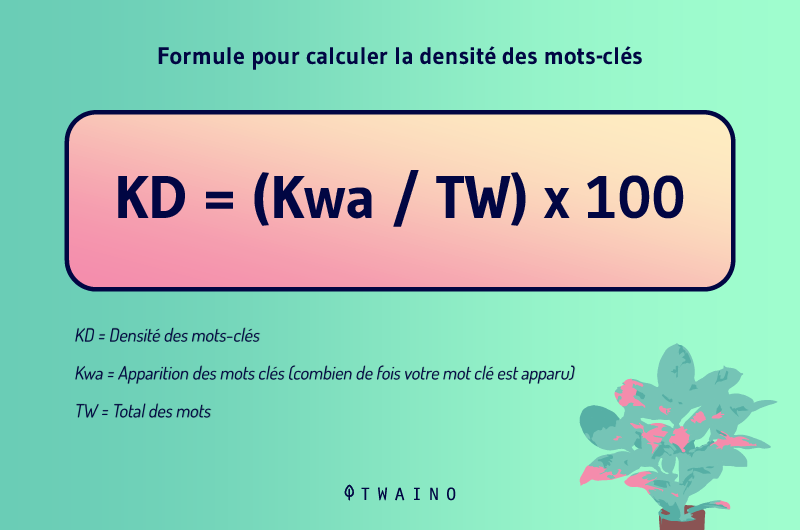
To better understand, let’s take an example and apply the formula
Let’s say you have produced a 1,000 word article on the keyword “natural weave” where you are trying to show the benefits your customers get from choosing your product brand.
In the course of your sales pitch, you have inserted the keyword “natural weave” 20 times.
The density for this keyword would be
D = ( 20 / 1 000 ) * 100
D = 2 %
With 20 as the number of times where “natural weave” is used on the page and 1,000 the total number of words contained on the page
1.3. What is the ideal density for a keyword?
Well, there is not an exhaustive answer to this question. There is no rule anywhere, not even provided by Google that states how many times a keyword should be used on a page.
Everything will be based on your common sense with some good practices to guide you
Nevertheless, in the absence of a convention, there are some opinions of SEO experts who estimate the ideal density of a keyword between 1 and 2%. This is equivalent to 1 or 2 appearances of the keyword, every 100 words.
At this interval, some SEOs believe that the keyword is sufficiently “relayed” to indicate to search engine bots that it is the theme of the page without giving the impression of a keyword stuffing.
Personally, I do not find it very effective to follow a frequency of appearance of a certain keyword. The risk of having parts of text that seem forced and mechanical is quite high
That’s why I tend to insert the main keyword naturally, while making sure to add other terms that are semantically related to it. These can be synonyms or any other expression that usually appears with the main keyword.
Before we look at best practices for ideal keyword density, let’s take a quick look at the meaning of the term keyword stuffing.
1.4. What is keyword stuffing?
The keyword stuffing is the abusive repetition of a keyword on a page in order to force its referencing on the pages of search engines.

For a long time, the technique went unnoticed and really helped sites to improve their positions on the SERPs. But very quickly, Google realized it and classified keyword stuffing as a black hat technique
This means that it is now a fraudulent technique used to try to bypass Google’s restrictions and get a good ranking.
Although keyword stuffing is not used today as it used to be, you should still be informed to avoid using it accidentally
With the formula from earlier, you can check if your keyword density is too high and review its frequency of appearance.
This keyword density check is to be taken seriously and must be done for each content you produce. Especially since Google punishes keyword stuffing
The search engine could make you lose your current ranking, even removing the page concerned from its SERPs if this rule is not respected

Moreover, a too high density on a page does not leave a good impression to your audience, which ruins the user experience you offer on the site.
Using a keyword all the time in a content dulls its clarity and readability, which can even lead users to abandon your site in favor of another one that offers quality content.
To help you, here are some good practices to follow to offer content with a good density of keywords and thus improve the experience of your users for a good ranking on search engines
Chapter 2: 4 good practices to follow to have a good keyword density
Since there is no recommendation from search engines on the exact keyword density to respect, it becomes important that you rely on good keyword optimization practices.
Here is a selection of the best strategies to use to properly address keyword frequency in your content
2.1. Write for your users first
To get a good keyword density, it is important to prioritize the satisfaction of your users. And for that, forget for a moment this pressure to insert your keywords at all costs and write naturally for your audience
You have to keep in mind that a better content is above all a content that your readers like first.
Many companies make the mistake of rushing to write just to get a good ranking on search engines. Yet the best way to do this is to focus on creating content for your audience first.

By focusing on producing quality content that is truly compelling and adds value to your readership, you’ll notice that you’re using a conversational tone that makes it easy and convenient for your keywords to stand out.
Once you’ve written your content, you can always reread everything and check if the keyword density is between 1 and 2%. If it is not, try inserting it at intervals of about 100 or 200 words when proofreading, taking into account of course the context of each sentence.
Your main concern should be to write quality content that prioritize the interest of Internet users before your own. Especially since Google advocates user experience and recognizes it as a real factor of referencing on its SERPs.
It must be said that search engines are becoming more and more intelligent and will be able to know if you guarantee a good user experience on your pages or not.
Moreover, sites that offer a better experience with quality content have a certain ease to retain users because they are a reference source that users can always rely on.
To help you produce such content, you can consult my guide to web writing. You’ll find the different steps, mistakes to avoid and tips for successful and SEO optimized web writing.
2.2. insert your keywords in strategic places
Maintaining an ideal density of your keyword to get a better SEO cannot be done without using this keyword in certain parts of your page.
These are the “vital” parts outside the body of the article where Google also collects information on the theme of your page during the crawl. Among these strategic parts, we have
- The H1 tag ;
- The H2 tags ;
- The beginning of the content ;
- The end of the content ;
- The URL of the page;
- The Title tag ;
- The meta description
Apart from the body of your content, you should also make sure to insert your keyword in the titles and subtitles, especially in the H1 title (H1 tag)

Google uses the content of this tag to understand the theme that you address on your page in order to rank your page among its results as soon as a user formulates a request on this same theme.
Then comes the h2 tag tag, which is just as important. By using the same keyword inserted in the H1 in the H2, you confirm to Google that it is your main keyword and that it must take it into account when indexing your page
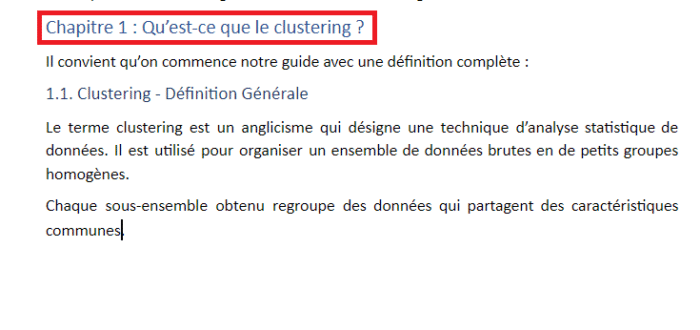
As for the content, it is true that we talked about a frequency at which the keyword must appear, but it is recommended to start the insertion from the first paragraph and end with the last.
This is a way to reaffirm to Google, the choice of your main keyword. However, everything is not only about the page and its content. Google also takes into account places outside the page, to ensure that it is indeed the main keyword.
These are the title tags and Meta description which are only visible on Google results pages. The Title tag represents the clickable title and the Meta description, the small description below the Title.
You must also insert your main keyword, since it is essential for your page to be ranked on Google SERPs
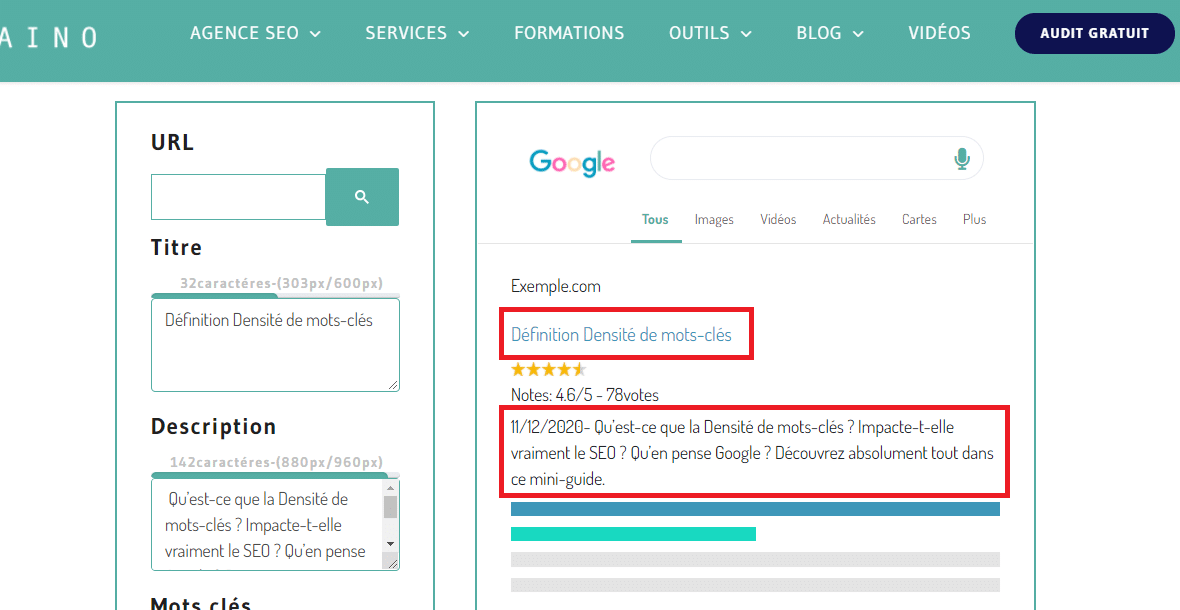
Finally, the URL of your page must also contain its main keyword. This will improve the ranking of the page and the whole site for that matter
2.3. Use variations of your main keyword
Every day, Google receives more than 6 billion queries of which 15% are completely new queries. And when we say “completely new”, it means they are really new.
That is to say that these 15%, or 500 million queries, are keywords that have NEVER been searched by Internet users on the search engine before.
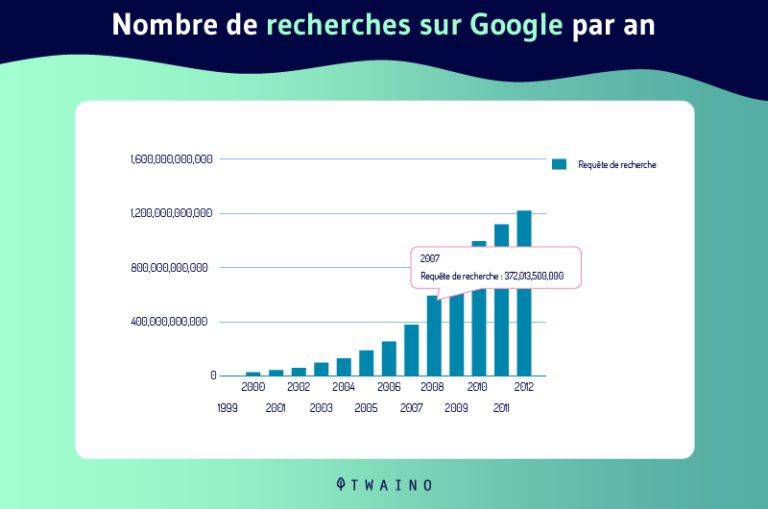
This may seem quite surprising, but it can be explained by the fact that the way in which Internet users formulate their queries today differs from what we have seen in the past.
With the advent of voice search and artificial intelligence, the interaction between humans and search engines has literally changed. The observation is that people are constantly creating new expressions to express their queries.
In particular, we have long tail keywords that are often in the form of conversational queries and are becoming more and more targeted by web marketers because of its high conversion rate.
As a result, the relevance of a content is no longer limited to the exact repetition of the same keyword at a good frequency.
It will also be necessary to “support” this keyword with variants to cover as many keywords as possible while remaining in the context of the article.
This can include plurals of words, rephrased phrases, questions or closely related terms, but not necessarily synonyms.
This is a very important step in keyword usage that can even balance out low keyword density and help you achieve a good Google ranking.
However, it requires enough vigilance not to fall into keyword stuffing again. That’s why it is recommended to use terms that are close to the main keyword and that vary.
These variant terms must not replace the main keyword of the page. This means that they should not be taken into account when calculating the keyword density. They just reinforce the main term and help you to be listed in the suggestions of similar answers.

For example, let’s say you own a restaurant. One of your main keywords could be “cheap restaurant”. Supplementing this keyword with the names of cities is not a good variation.
Keywords like “cheap restaurant in Paris”, “cheap restaurant in Nice”, “cheap restaurant in Toulouse” and “cheap restaurant in Marseille” will always be considered as spam for Google.
It would be more appropriate to try keywords such as
- Cheap restaurant
- Affordable restaurant
- Low cost restaurant
- Etc
Even if these keywords are not word-for-word repetitions, they still mean the same thing.
By using these variations of your main keyword as well, your site will rank on Google for “cheap restaurant”, but also for all other variations.
So to get good keyword density, also insert variants to gain the first pages of Google without filling your text with the main keyword
2.4. Check and correct the keyword density on your old pages
If you can now build an ideal keyword frequency for your new content, what about your old content?
Can you make sure they all meet a good density? That’s why it’s important to test your old pages and correct their keyword frequency if possible.
But if you have huge amounts of content on your site, you may be exhausted trying to test them all, page by page. Fortunately, there is a way to shorten things and still be effective.
It’s to check some of your site’s metrics to unearth the content that’s really valuable to you.
But first, test the site as a whole to see what kind of impact the keyword density has had on your ranking. If the result is positive, so much the better.

If not, continue your metrics research to find the pages that you think you did well, but in the end did not have the success they deserved.
Go back to these pages, maybe the problem is that the density is too low or too high. So check if the density is between 1 to 2% for each of these pages for each of these pages.
To do this, you have the choice between doing it manually or with a dedicated tool. The first option is to count the number of times the keyword appears in the content by hand
Certainly it is tedious to count words in a content from a computer screen.
The fastest way is to use a word counter to get an automatic estimate
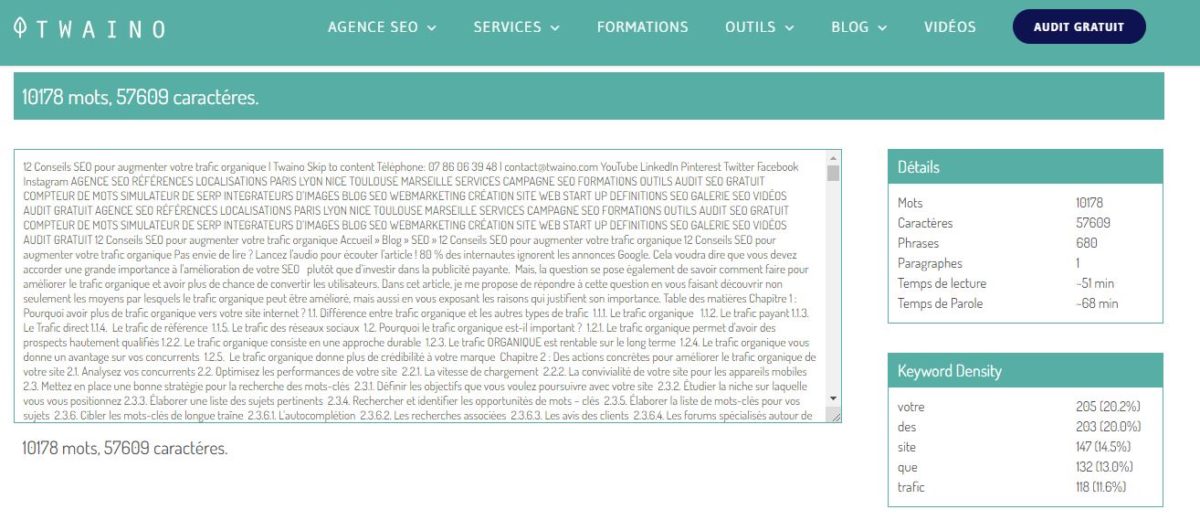
The other little trick, you can combine the keys “Ctrl” + “F to go fast. This is a keyboard shortcut that allows you to search for words in a Word, PDF or Google Docs document.
After combining these keys, a small search bar will appear at the top of your screen. Enter your main keyword accurately and the system will automatically tell you how many times that word appears in the document
It will also highlight the keyword so that you can easily distinguish it

As for the total number of words, Word and Google Docs have a built-in word counter that gives you the number of words you type as you go.
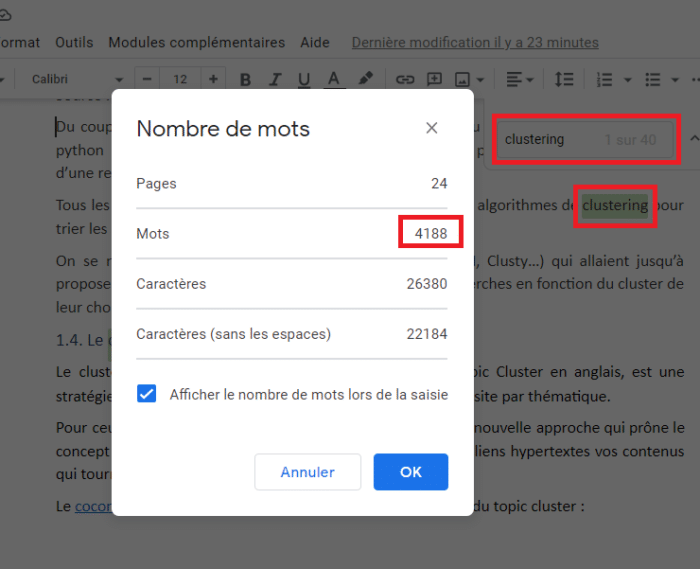
For the capture above, we can see that the entire article is about 4188 words. The main keyword is “clustering” and appears 40 times, which is a density of about 1%.
The second option is to use tools such as the Yoast SEO. It is used to check the keyword density of a content directly from the WordPress publishing space.
Once the content is published, you still have the possibility to do a final check to make sure you have done your job. This time, the verification will be with online tools like
The use of these tools is quite simple
- You paste the text written or directly the link of the page
- You then fill in the keyword(s) and launch the search

As for the metricsyou will find them on Google Analytics. The tool allows you to follow the traffic of your site before and after the correction of the keyword density
The comparison between these two values will allow you to appreciate if the keyword frequency really has an impact on SEO
Chapter 3: The importance of keyword density for SEO: Myth or reality?
Today, opinions on the importance of keyword density for SEO remain quite divided. While some believe that the more a keyword is cited on a page, the better the page will be referenced on Google, others say completely the opposite.
For the latter, keyword frequency is of little or no importance for the SEO of a page.
There are many bloggers, SEO experts … to support this position and the words they use to express it are quite hard. For many of them, including Matt Cuttsfor many of them, including Matt Cutts, the density of keywords has been overestimated, others speak of folklore or myth
Then comes the version of Google that silences all speculation. The leader of online search has acknowledged that the frequency of keywords is no longer effectively taken into account in its algorithms as a criterion for referencing.
But that doesn’t mean you should neglect it. If the density can not improve the SEO of your site, it can harm it if you ignore it.
Google has admitted that it has removed it from its SEO criteria, yet the search engine still checks the density of keywords of indexed sites to discourage keyword stuffing. So be careful not to end up downgraded
Chapter 4 : Other questions asked about keyword density
4.1. How is calculated the keyword density of a web page?
To evaluate the frequency of keywords that a web page contains, simply take the number of times the main keyword appeared and divide it by the total number of words that the page contains. The keyword density of this page is the number resulting from this operation.
4.2. What is a good keyword density?
77Most SEO experts believe that an ideal keyword density is about 1-2%. This means that the main keyword appears about once or twice every 100 words. In fact, a low keyword density has no influence (positive or negative) on the SEO of a page. The most important thing is to avoid keyword stuffing.
4.3. Is keyword density still important today?
YES, keyword density still matters. We hear a lot less about it today in SEO circles, but it is still a plus. Even though Google no longer considers it a ranking factor, neglecting or misusing it can really hurt your website’s SEO.
4.how many keywords should be targeted on a page?
Sometimes you may want to target two or three keywords per page, even if they are only close variants. But more than one keyword is already too many. After all, each page only has one title tag and one meta description.
4.5. How to recognize a keyword?
Keywords are the words or phrases that people type into the search engine bar to find what they are looking for. For example, if you are looking to buy a new shoe, you might type into the search bar something similar to: “men’s leather shoe”. Even if this phrase consists of more than one word, it is still a keyword.
4.6. What are the types of keywords?
There are three types of keywords:
- Short-tail keywords or broad or generic: often range from one to two words with a high search volume;
- Mid-tail keywords they are composed of two to three words with a medium search volume;
- Mlong-tail keywords they usually consist of 4 or more words in a row, and have a relatively low search volume.
4.7. How to use keywords correctly?
- Assign a main keyword to each page;
- Produce content that is longer than 300 words;
- Use your target keyword throughout the content, but in moderation;
- Add secondary keywords, synonyms and long-tail keyword variants to the content;
- Place keywords in the right places on your page;
- Check your on-page SEO.
Conclusion
Keyword density is among the most controversial SEO concepts. It refers to the frequency with which the main keyword of a page or content is cited in relation to the total number of words.
Even if its importance is not unanimous among various actors of SEO, it is still an important strategy. Especially since a density too high leads to keyword stuffing which is a black hat practicepractice, sanctioned by Google




1 thought on “Keyword density”